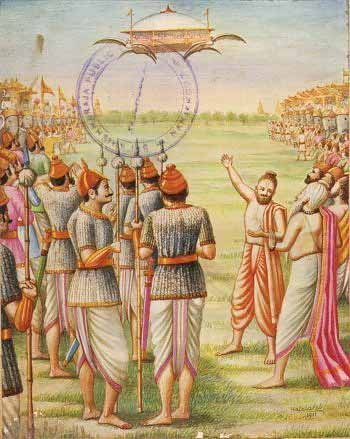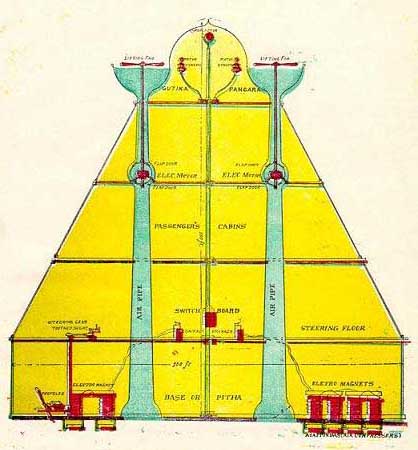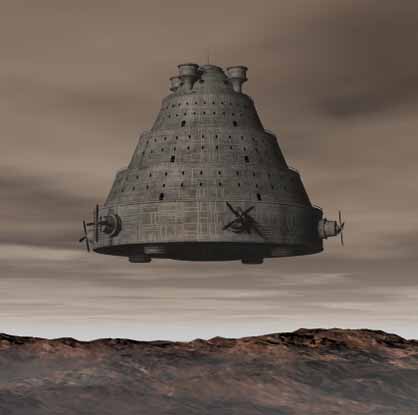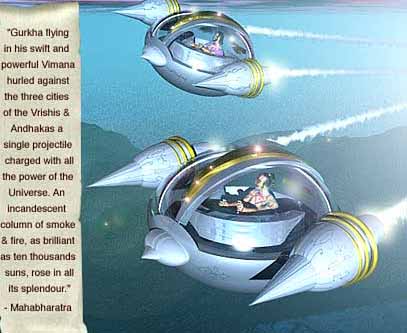
Evidence of unexplained ancient aircraft can be found across the planet
especially in areas where major civilizations once thrived. Physical
evidence of alien intervention in human history is undeniable.
Ancient Astronaut Theory seeks to explain alien presence in the past linked with
Ancient Aircraft
and purported landing strips, especially in areas like India (Vimanas),
Egypt, and Mesoamerica. Pictographs and megalithic monuments describe
human interaction with these entities, allowing those in our timeline to
piece together what happened in the past that shapes out destiny today
as humanity evolves beyond this
consciousness hologram.


A
vimana
is a word with several meanings ranging from temple or palace to
mythological flying machines described in Sanskrit epics. References to
these flying machines are commonplace in ancient Indian texts, even
describing their use in warfare. As well as being able to fly within
Earth’s atmosphere, vimanas were also said to be able to travel into
space and travel under water.
Descriptions in the Vedas and later Indian literature detail vimanas of various shapes and sizes:
- In the Vedas: the Sun and Indra and several other Vedic deities are
transported by flying wheeled chariots pulled by animals, usually horses
(but the Vedic god Pusan’s chariot is pulled by goats).
- The “agnihotra-vimana” with two engines. (Agni means fire in Sanskrit.)
- The “gaja-vimana” with more engines. (Gaja means elephant in Sanskrit.)
- Other types named after the kingfisher, ibis, and other animals.
The word comes from Sanskrit and seems to
be vi-mana = ‘apart’ or ‘having been measured”. The word also means a
part of a Hindu temple. The meaning of the word likely changed in this
sequence:
- An area of land measured out and set apart to be used for sacred purposes.
- Temple
- A god’s palace
- In the Ramayana: the demon-lord Ravana’s flying palace called Pushpaka.
- In later Indian writings: other flying vehicles, and sometimes as a poetic word for ordinary ground vehicles.
In some modern Indian languages, the word vimana means ordinary real aircraft.
The Buddhist book Vimanavatthu
(Pali for “Vimana Stories”) uses the word “vimana” with a different
meaning: “a small piece of text used as the inspiration for a Buddhist
sermon”.
Sanskrit texts are filled with
references to gods who fought battles in the sky using vimanas equipped
with weapons as deadly as any we can deploy in these more enlightened
times.
In the Ramayana there is a passage in the Ramayana which reads:
-
“The Pushpaka chariot that resembles the Sun and belongs to my
brother was brought by the powerful Ravana; that aerial and excellent
car going everywhere at will …. that car resembling a bright cloud in
the sky … and the King [Rama] got in, and the excellent car at the
command of the Raghira, rose up into the higher atmosphere.'”
“Pushpaka” is Sanskrit for “flowery”. It
is the first flying vimana mentioned in Hindu mythology (as distinct
from gods’ flying horse-drawn chariots). It is also called Pushpaka
Vimana.
The special characteristic of this
vehicle is, “What ever may be the number of people sitting in it, always
there will be one more seat vacant i.e., If N people sit, There will be
(N+1) seats”. It was basically a vehicle that could soar the skies for
long distances. It shows that even in ancient times, people were curious
about flight and might have tried to design flying vehicles.
Pushpaka was originally made by Maya for
Kubera, the God of wealth, but was later stolen, along with Lanka, by
his half-brother, the demon king Ravana.
The core epic of the Mahabharata
mentions no vimanas, but vimanas often occur in the large amount of
matter which was added to the Mahabharata corpus later. One example is
that the Asura Maya had a Vimana measuring twelve cubits in
circumference, with four strong wheels.
The Mahabharata is a veritable gold mine
of information relating to conflicts between gods who are said to have
settled their differences apparently using weapons as lethal as those we
have now. Apart from ‘blazing missiles’, the poem records the use of
other deadly weapons. ‘Indra’s Dart’ (Indravajra) operated via a
circular ‘reflector’. When switched on, it produced a ‘shaft of light’
which, when focused on any target, immediately ‘consumed it with its
power’.
In one exchange, the hero, Krishna, is
pursuing his enemy, Salva, in the sky, when Salva’s Vimana, the Saubha,
is made invisible in some way. Undeterred, Krishna immediately fires off
a special weapon: “I quickly laid on an arrow, which killed by seeking
out sound”. Many other terrible weapons are described, quite
matter-of-factly, in the Mahabharata, but the most fearsome of all is
the one used against the Vrishis. The narrative records:
“Gurkha flying in his swift and powerful
Vimana hurled against the three cities of the Vrishis and Andhakas a
single projectile charged with all the power of the Universe. An
incandescent column of smoke and fire, as brilliant as ten thousands
suns, rose in all its splendour. It was the unknown weapon, the Iron
Thunderbolt, a gigantic messenger of death which reduced to ashes the
entire race of the Vrishnis and Andhakas.”
It is important to note, that these kinds
of records are not isolated. They can be cross-correlated with similar
reports in other ancient civilizations. The after-affects of this Iron
Thunderbolt have an ominously recognizable ring. Apparently, those
killed by it were said to be so burnt that their corpses were
unidentifiable. The survivors fared little better, as it caused their
hair and nails to fall out.
Perhaps the most disturbing and
challenging, information about these allegedly mythical Vimanas in the
ancient records is that there are some matter-of-fact records,
describing how to build one. In their way, the instructions are quite
precise.
The Mahabharata also tells of the awesome
destructiveness of the war: “… (the weapon was) a single projectile
charged with all the power of the Universe. An incandescent column of
smoke and flame as bright as the thousand suns rose in all its splendor…
An iron thunderbolt, a gigantic messenger of death, which reduced to
ashes the entire race of the Vrishnis and the Andhakas…. the corpses
were so burned as to be unrecognizable. The hair and nails fell out;
pottery broke without apparent cause, and the birds turned white…. after
a few hours all foodstuffs were infected…. to escape from this fire,
the soldiers threw themselves in streams to wash themselves and their
equipment…” Some say that the Mahabharata is describing an atomic war.
References like this one are not isolated; but battles, using a
fantastic array of weapons and aerial vehicles are common in all the
epic Indian books. One even describes a Vimana-Vailix battle on the
Moon! The above section very accurately describes what an atomic
explosion would look like and the effects of the radioactivity on the
population. Jumping into water is the only respite.
In the Sanskrit Samarangana Sutradhara (Literally, “controller of the battlefield”), it is written:
“Strong and durable must the body of the
Vimana be made, like a great flying bird of light material. Inside one
must put the mercury engine with its iron heating apparatus underneath.
By means of the power latent in the mercury which sets the driving
whirlwind in motion, a man sitting inside may travel a great distance in
the sky. The movements of the Vimana are such that it can vertically
ascend, vertically descend, move slanting forwards and backwards. With
the help of the machines human beings can fly in the air and heavenly
beings can come down to earth.”

Introduction
Flight has been the dream of humankind since they watched in awe as
birds soared effortlessly through the sky. But, according to accepted
history, it wasn’t until the 1780s that two Frenchmen achieved
lighter-than-air flight when they were lifted into the air in a hot air
balloon near Paris. Then powered, heavier-than-air flight became the
goal. And although it was theorized that heavier-than-air flight was
possible as early as the 13th century, and in the 16th century Leonardo
da Vinci designed winged aircraft and a crude kind of helicopter, it
wasn’t until the Wright brothers made their first successful flights at
Kitty Hawk in 1903 that powered flight became a reality.
That’s the widely accepted history. Some researchers and a few rogue
scientists believe there’s evidence to suggest that humans achieved
flight earlier in history – much earlier… so early, they say, that the
knowledge of this technology has been lost and ancient stories that
recount adventures of human flight have been relegated only to myth.
Is it possible that humans developed the technology to fly in early
civilizations – or in civilizations that are now lost to history? Let’s
take a look at what some call the evidence – intriguing artifacts,
carvings, inscriptions and legends – that they say point to the true
record human of flight.
Colombia
Airplane Models
©1996 Lumir G. Janku. All rights reserved. Reprinted with permission.
This object (shown in sketch) was found in 1898 in a tomb at
Saqquara, Egypt and was later dated as having been created near 200 BCE.
As airplanes were unknown in the days when it was found, it was thrown
into a box marked “wooden bird model” and then stored in the basement of
the Cairo museum.
It was rediscovered by Dr. Khalil Messiha, who studied models made by
ancients. The “discovery” was considered so important by the Egyptian
government that a special committee of leading scientists was
established to study the object.
| As a result of their findings, a special exhibit was set
up in the center hall of the Cairo museum, with the little model as its
centerpiece. It was even labelled as a model airplane. |
|
To elucidate the reasons for the decision of the committee, almost
unprecedented in the field of archeology, let’s consider some aspects of
the model. The model has the exact proportions of a very advanced form
of “pusher-glider” that is still having “some bugs ironed out”. This
type of glider will stay in the air almost by itself—even a very small
engine will keep it going at low speeds, as low as 45 to 65 mph., while
it can carry an enormous payload. This ability is dependent on the
curious shape of wings and their proportions. The tipping of wings
downward, a
reversedihedral wing as it is called, is the
feature behind this capability. A similar type of curving wings are
implemented on the Concorde airplane, giving the plane a maximum lift
without detracting from its speed.
In that context, it seems rather incredible that someone, more than
2,000 years ago, for any reason, devised a model of a flying device with
such advanced features, requiring quite extensive knowledge of
aerodynamics. There were no such things as airplanes in these times, we
are told by archeologists and historians. But this case seems to be an
exception, living in the midst of the rather unimaginative and rigid
paradigm of contemporary science. It is also necessary to point out that
Egyptians are known to have nearly always made scale-models of projects
and objects which they planned to create or build.
—
Once you purchase your own plane, consult an aviation lawyer
to make sure you cover the all of the bases on plane ownership
—
Precolombian Airplane Models
Is the concept of an airplane limited to Egypt? That doesn’t seem to
be the case. Gold trinkets were found in an area covering Central
America and coastal areas of South America, estimated to belong to a
period between 500 and 800 CE, but since they are made from gold,
accurate dating is impossible and based essentially on stratigraphy
which may be deceptive. However, we can safely say that these gold
objects are more than 1000 years old.
Whatever this object is supposed to be or represent,
its remarkable resemblance to a modern aircraft or spacecraft is uncanny.
As seen from the pictures, the shape of the sample object is rather ambiguous. The archaeologists labelled these objects as
zoomorphic, meaning,
animal shaped objects.
The question is, what animal do they represent? When we compare these
with other objects from the same cultures depicting animals, a curious
facet of the comparison would be obvious: the other objects are
recognizable, rendered usually with a great accuracy and attention to
realistic detail.
There are several types of animals which fly—birds, insects, and
several mammals, such as bats and some gliders, for instance flying
squirrels, oppossums, and then there are some lizards; there are also
some fish which for brief periods glide through the air. There are water
animals which seem to
fly through the water, such as rays,
skates and some selachians. But how does the depicted object compare
with these choices? All its features taken into a consideration, we have
no match. Seen from above, the object obviously has no fish features,
but seems to show rather explicitly mechanistic ones.
The structures just in front of the tail are strongly reminiscent of elevons
(a combination of ailerons and elevators) with a slight forward curve,
but they are attached to the fuselage, rather than the wings. In any
case, they look more like airplane parts than like the claspers of a
fish. If the two prominent spirals on the wings are supposed to be a
stylized version of the eyes of a ray, then what are the two globular
objects positioned on the head supposed to represent? To complicate the identification even more, the spirals on the wings have their copies
positioned on the nose of the object, in the opposite direction. When
the object is viewed in profile, the didsimilarity to anything from the
animal kingdom is even more pronounced. If the zoomorphic explanation is
supposed to hold, then why did the artist cut the head off
almost three quarters from the body? And why is the nose is practically
rectangular and the cut tilted forward, with eyes positioned at either
side, when fish eyes are usually more near the center of bodyline and
far forward on the head?
What we can make of the semicircular grooves on the inside of the
cut? What is it supposed to be—fishwise? And what about the
scoop, forward and under the
cut?
It is a scoop, not just a ridge for drilling a hole through to place
the object on a necklace chain. Then there is another rectangular
feature, positioned further back at the approximate center of gravity
under the fuselage. The wings when viewed from the side are perfetly
horizontal, but when seen from the front, they curve slightly downward.
The
elevators, which are right behind the wings, are positioned
on a slightly higher horizontal level and are square-ended, thus a
definite geometric shape. Above them is another rectangular shape, with a
relief which may be reminiscent of
knobs. The tail is equally
intriguing. No fish has only a single, upright and perpendicular flange.
But this tail fin has an exact shape of
fins on modern
airplanes. There are also some markings on the tail which are hard to
identify, but it does not seem to be anything related to animals,
either.
When all the features are taken into an account, the object does not
look like a representation of any known animal at all, but does look
astonishingly like an airplane. The photos and enlarged outline of the
object has been submitted for an analysis to several people from the
field of aerodynamics. One of them was Arthur Young, a designer of Bell
helicopters and other aircraft. His analysis confirmed that the object
contains many features which would fit the airplane hypothesis, but
there were several ones which would not fit that scenario. Wings do seem
to be in the wrong place—they should be further forward so that their
1/4-chord coincides with the center of gravity. The nose is not like
anything on airplanes, as well. So, while the object is suggesting an
airplane, some features would not seem to support this hypothesis.
But let’s entertain several possibilities. If we imagine that the separation after the windshield is not a cockpit and that the pilot and the cargo were located somewhere in the main fuselage body, then we can envision the nose
as something else. Let’s assume that the nose is actually a jet. If the
machine needs to slow down, the jet flow directed against the path of
flight would accomplish just that. But how to redirect the jet into the
opposite direction? If we envision the nose as a movable part of the
plane, turning around the point located where the nose and fuselage
meet, thus pivoting the nose downward to tuck it under the fuselage,
that would enable the desired effect. What’s more, it will re-adjust the
center of gravity and the wings would be just in the right place for a
high powered flight. Another problem, though, will appear and that is
the drag which would be created by the back of the nose now positioned
in front. But that can be attributed to artistic license. That seems to be the case, because several other similar planes feature the back part of the nose tilted more forward, so the angle of the back of the nose when pivoted is more corresponding to aerodynamic principles.
All things considered, the object seems
to represent a convertible type of craft, with two possible
configurations—one for ascent when the nose is facing backwards, and the
other for descent with the nose facing forward. One unsolved item
remains—the spirals on the both wings and the nose. According to
Amerindian iconography, these spirals have discernable meaning—they
represent ascending and descending, depending on whether they are
right-oriented or left-oriented, respectively. As the spirals are not
only on wings but also on the nose, the meaning is fairly obvious—the
wings and the nose (as much) were the features which were directly
involved in ascent and descent.
There are other cultures which mention
flying vehicles of some sort or another. The most known of these sources
are Indian epics, especially the Mahábhárata and other Védic sources as
Bhágavata Purána and Rámáyana. The flying devices were called vimánas and were extensively discussed in Vaimánika Shástra, describing multitude of machines with different purposes and capabilities.
Other source of information about flying
machines may be considered, such as the Bible and some apocryphal works.
The book of Ezekiel seems to be describing the close encounter of a man
from a non-technological culture with a device which to him must have
been miraculous. We have to put ourselves into his shoes to comprehend
his astonishment and the otherworldness of his encounter. The limited
scope of knowledge of the world around him, his primitive environment,
dictated the language and conceptual framework with which he tried to
capture his encounter for fellow tribesmen. For him it seemed that he
encountered The God, with his suite of angels, because in his simple world, there was no other interpretation. It is not necessary to reach for an alien
type of scenario to explain the encounter; we can entertain a
possibility that a remnant of an advanced civilization was still
present, in a limited scope, at the time of Ezekiel. But for some, the
encounter bears uncanny similarity to the modern-day encounters with
UFO’s. Another source of similar material is the Book of Enoch,
particularly the Slavic version, which contains some parts which the
Greek version is missing. The book not only describes flying in the air,
but also through outer space, including the relativistic effects
mentioned—Enoch spent several days on a spacecraft, but when he returned
to Earth, several centuries had passed by.
There is no shortage of descriptions of
flying machines in ancient sources. If we try to extract the core of
myths of different provenience and remove the embellishments, we
discover to our surprise that flying in ancient times seems to be the
rule, not the exception.
Sanskrit texts are filled with
references to gods who fought battles in the sky using Vimanas equipped
with weapons as deadly as any we can deploy in these more enlightened
times. For example, there is a passage in the Ramayana which reads:
“The Puspaka car that resembles the Sun
and belongs to my brother was brought by the powerful Ravan; that aerial
and excellent car going everywhere at will …. that car resembling a
bright cloud in the sky.”
“.. and the King [Rama] got in, and the excellent car at the command of the Raghira, rose up into the higher atmosphere.”
In the Mahabharatra, an ancient Indian
poem of enormous length, we learn that an individual named Asura Maya
had a Vimana measuring twelve cubits in circumference, with four strong
wheels. The poem is a veritable gold mine of information relating to
conflicts between gods who settled their differences apparently using
weapons as lethal as the ones we are capable of deploying. Apart from
‘blazing missiles’, the poem records the use of other deadly weapons.
‘Indra’s Dart’ operated via a circular ‘reflector’. When switched on, it
produced a ‘shaft of light’ which, when focused on any target,
immediately ‘consumed it with its power’. In one particular exchange,
the hero, Krishna, is pursuing his enemy, Salva, in the sky, when
Salva’s Vimana, the Saubha is made invisible in some way. Undeterred,
Krishna immediately fires off a special weapon: ‘I quickly laid on an
arrow, which killed by seeking out sound’. Many other terrible weapons
are described, quite matter of factly, in the Mahabharata, but the most
fearsome of all is the one used against the Vrishis. The narrative
records:
“Gurkha flying in his swift and powerful
Vimana hurled against the three cities of the Vrishis and Andhakas a
single projectile charged with all the power of the Universe. An
incandescent column of smoke and fire, as brilliant as ten thousands
suns, rose in all its splendour. It was the unknown weapon, the Iron
Thunderbolt, a gigantic messaenger of death which reduced to ashes the
entire race of the Vrishnis and Andhakas.”
It is important to note, that these kinds
of records are not isolated. They can be cross-correlated with similiar
reports in other ancient civilizations. The after-affects of this Iron
Thunderbolt have an ominously recognizable ring. Apparently, those
killed by it were so burnt that their corpses were unidentifiable. The
survivors fared little etter, as it caused their hair and nails to fall
out.
Perhaps the most disturbing and
challenging, information about these allegedly mythical Vimanas in the
ancient records is that there are some matter-of-fact records,
describing how to build one. In their way, the instructions are quite
precise.
In the Sanskrit Samarangana Sutradhara, it is written:
“Strong and durable must the body of the
Vimana be made, like a great flying bird of light material. Inside one
must put the mercury engine with its iron heating apparatus underneath.
By means of the power latent in the mecrcury which sets the driving
whirlwind in motion, a man sitting inside may travel a great distance in
the sky. The movements of the Vimana are such that it can vertically
ascend, vertically descend, move slanting forwards and backwards. With
the help of the machines human beings can fly in the air and heavenly
beings can come down to earth.”
The Hakatha (Laws of the Babylonians)
states quite unambiguously: “The privilege of operating a flying machine
is great. The knowledge of flight is among the most ancient of our
inheritances. A gift from ‘those from upon high’. We received it from
them as a means of saving many lives.”
More fantastic still is the information
given in the ancient Chaldean work, The Sifrala, which contains over one
hundred pages of technical details on building a flying machine. It
contains words which translate as graphite rod, copper coils, crystal
indicator, vibrating spheres, stable angles, etc.







